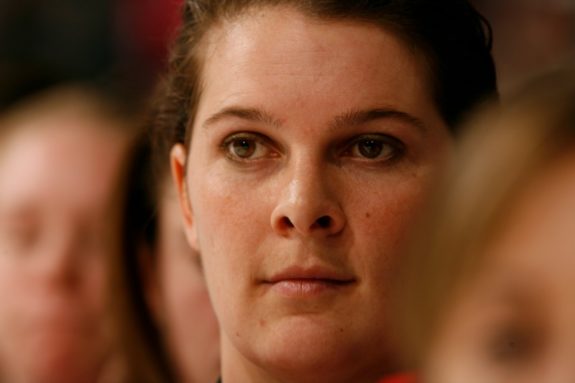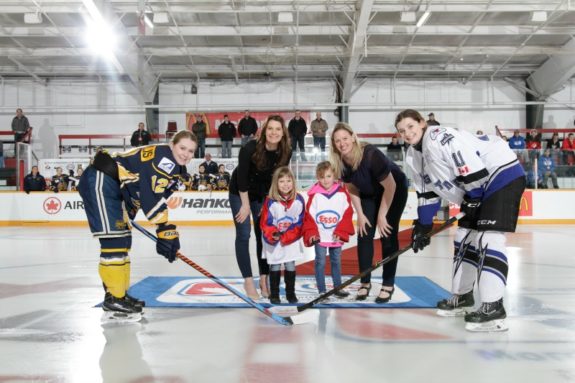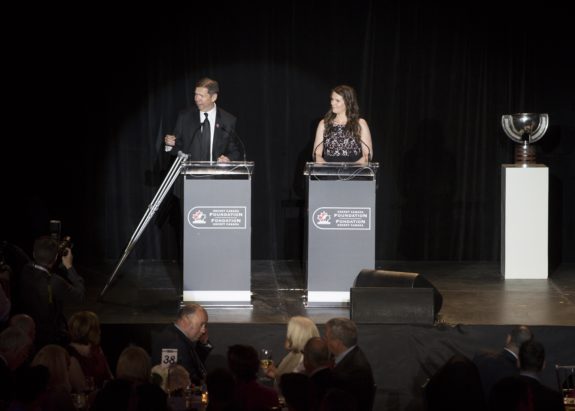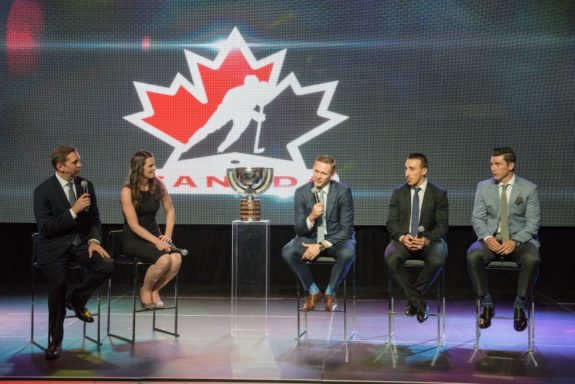Grace. It is a special type of athlete that possesses it off the rink. A caliber of person that comes once in a blue moon. Grace that is exuded in their words, in their actions, and in their character. We find it most often in the all time greats of the game. Gretzky, Howe, Orr, Lemieux, and Beliveau have each typified and defined what it means to have it. When they converse with others, the warmth of their presence is felt. Jennifer Botterill joins these gentlemen with this same unique capability. She exudes grace.

Botterill has experienced more and done more for women’s hockey than most other players. In the history of Olympic hockey and in women’s hockey in general she is one of the most decorated figures . The Hockey Hall of Fame has inducted female players on four occasions — Cammi Granato, Angela James, Geraldine Heaney, and Angela Ruggiero. Equally, Botterill is deserving of enshrinement too. Hopefully that will happen sooner than later.
Botterill’s Achievements
Let’s break down a few telling signs from Botterill’s career that properly depict her greatness as a player.
The numbers that Botterill produced at Harvard University are simply staggering. In 113 games she scored 340 points – a Crimson team record that will likely never be touched. Other records she holds for Harvard include career goals scored (157), career points per game (3.009), most points in a season (112), and most assists in a season (65).
On the international ice surface, Botterill’s achievements are even more impressive. In the IIHF Women’s World Championships, Botterill represented Canada and walked away with five gold medals (1999, 2000, 2001, 2004, 2007). Add three silver medals (2005, 2008, 2009) on top of that. Those eight medals constitute 40 games played in which she scored 26 goals and 33 assists for 59 total points.
Vancouver 2010
Botterill appeared in four Winter Olympics and she is one of only four Canadian players to have played in the first four Olympics since the inception of women’s hockey in 1998 in Nagano. Canada would collect a silver medal in Nagano. Botterill and her countrywomen would follow that up with three consecutive golds in Salt Lake City (2002), Torino (2006) and Vancouver (2010). Botterill’s 21 Olympic appearances saw her record 4 goals, 11 assists and 15 points.
“I feel very fortunate. I look back and there are a lot of special moments for me. A couple certainly come to mind. Winning the Olympic gold medal on home soil in 2010 in Vancouver was pretty extraordinary. I think it exceeded any expectations that we had for the entire experience. Getting the chance to be successful and to achieve your dream, and have so many family and friends be a part of it, and the atmosphere there. I think that would be right up there,” Botterill shared.
In her final Olympic appearance in 2010, Botterill played five games, recorded two assists, and finished as a plus-seven for the tournament. More importantly, she assisted on the game winning goal in Canada’s 2-0 victory over the United States to capture that home soil gold.
Botterill continued on to say, “there are some other special moments. Winning World Championships with Canada, and when we won the national championship when I was playing with Harvard University. Those are a few others that I think are on the top of my list. I look back and I loved my four years of playing university hockey. Then I look back and I think that there are quite a few special moments when I had the chance to play for the national team as well.”
A Pioneer For Women’s Hockey?
Looking at her longevity in the sport and all of those aforementioned achievements place Botterill in a unique category. At Nagano Botterill was all of 18 years old when she took to the ice. With her time spent playing the game, does she consider herself a pioneer for women’s hockey?

“It’s an interesting term,” she said. “Certainly I would be honored for that description, but I look to the people before me. I think that the game is very much evolving which is great. I certainly look at the veterans who I played with and who played on Team Canada before I made that team. Then the players on Team USA who played those national teams before I had the chance to make the roster. Those are the ones who I look at who were pioneers. But of course when you look at the history of the CWHL and the growth of the game, I think it has changed a lot over the course of the past little while.”
“I think that all of us who played during my era took a lot of pride in playing in those positions and also we wanted to continue to grow the game. I think it’s grown a lot, but we want to continue to see it grow even more.”
Old NWHL To CWHL

Helping to grow the game, Botterill most certainly did. She was arguably the best player in the early years of what has now become the highly successful CWHL. The league comprises some of the finest talent in women’s hockey. Botterill’s contribution to the beginnings of the league most assuredly gave it credence.
Botterill played three years in the now defunct NWHL (not to be confused with today’s current NWHL) with the Toronto Aeros and the Mississauga Aeros. She would record 67 goals and 83 assists for 150 points in only 86 games.
Those three years were followed up by three in the CWHL. There she would play for the Mississauga Chiefs and the Toronto Aeros, who have since become the Toronto Furies. Botterill’s career CWHL numbers are even better. In 78 games she scored 61 goals and 94 assists for 155 points.
The CWHL named Botterill the Top Forward and an All Star during the 2007-08 CWHL season . She would also receive the Angela James Bowl which is awarded to the top point scorer in the CWHL each season. Botterill’s 61 points in 26 games saw her become the first player to capture the trophy in league history.
Kunlun Red Star Joins CWHL
Fast forward to present day. The CWHL has recently welcomed in a new team and it is one that comes from afar. The Kunlun Red Star WIH which will hail from Shenzhen, China. Former Boston Blades head coach Digit Murphy has assumed the duties behind the bench. American Kelli Stack, formerly of the Boston Blades and the NWHL’s Connecticut Whale has signed with the club, as has one of the best goaltenders in world, Noora Raty from Finland. Botterill likely could never have surmised that nearly a decade after she won the league’s first scoring trophy, one of the CWHL teams would be from China.
“I think it’s great,” Botterill said. “I think it has been part of a big discussion about the overall development of the game globally. The way I would describe it is that Canada and the US have improved so much, and so have other countries. If you look at that shifting scale – as they have gotten better, so have some of the teams from North America. I think that to see this team from China and knowing that they are taking some strides, it will improve their program leading up to the Olympics (2022 Winter Olympics in Beijing).”
How The Women’s Game Has Evolved
“I was around the MasterCard Center when they had some tryouts to find some different talents from across the country to be a part of their team as well. It is an exciting day. They have a great coach in Digit Murphy who coached in the NCAA for years and the CWHL as well. I had a chance to talk to her as well, and she seemed thrilled to be on the ice with the team. It is an exciting thing.”

“If you see how much the game has changed and evolved in North America over the past 15 to 20 years it is significant. Looking back at how much it has changed from the 90s to the first Olympics in ’98. There are some drastic changes, and there is potential there for other countries as well. I think it is a very exciting step for the growth of the game globally.”
Thoughts On A CWHL/NWHL Merger
There have been rumors and rumblings that the Canadian Women’s Hockey League and the National Women’s Hockey League could merge. A merger would make sense in many ways. Not including China, the geographical coverage of the present teams in both leagues looks appealing. Looking at the two leagues’ presence in the northeast alone – Montreal, Buffalo, Connecticut, and two in Boston – it is reminiscent of a 1980s NHL Adams Division. The potential for rivalries could be intense. Botterill shared her thoughts on a potential merger.

“I wish that I had a definitive answer on how to make that happen because I do think that it would be beneficial. I think that in terms of the leagues, having the best talent together and collaborating would create the strongest league. It would also attract the best players from many different countries. I think there are many people that would agree. Everyone is going to have their own opinion on what steps need to be taken. I think there needs to be continued open discussions and a business platform created that people are excited to support.”
Merger Seeds Already Planted
If a merger would in fact take place, Botterill knows that it would need to be well planned and performed methodically. The last thing any supporter of the women’s game would want is for a merger to detract or hinder either league. If done correctly though, the seeds of a merger have already been planted. Positive examples can be found in women’s professional leagues for other sports, as well as the NHL itself.
“Things may not happen with a snap of a finger,” Botterill went on to say. “If you look at different women’s sports and different examples, whether it be soccer or basketball, and different steps that they’ve taken to get to the stage that they are at. I think women’s hockey is growing in terms of the grassroots level and that carries forward. I don’t know if I have the exact solution of what I think should happen, but yes, I do believe that there should be further communication and figuring out a platform – a business plan – that makes sense so that the best players could compete in the same league.”
Botterill likened a merger between the CWHL and the NWHL to that of the NHL and the former World Hockey Association (WHA) in the late-1970s.
“Look at the men’s leagues. They have had different phases where there were different leagues. There were people playing in the WHA, and then they all finally came together to form the NHL. It is important to look at different sports and the different paths that leagues have taken.”
Growing And Supporting Women’s Hockey
Botterill is very much in touch with women’s hockey. She keeps her finger on the pulse and her ears pricked up. More than just having been a superstar herself, she is able to look at the cultural climate of the women’s game from a unique perspective. Botterill is a four-time Canadian Olympian but she is also one of the most accomplished NCAA athletes in US history. Not many folks have a perspective of that kind.
Took to the ice with former @MapleLeafs Captain @wendelclark17 to chat '93 division semi finals. Game 7 vs.Wings pic.twitter.com/plKssK7Ot3
— Jennifer Botterill (@JenBotterill) December 8, 2016
“In terms of support, I think it is the awareness piece,” Botterill explained. “Feedback is often quite positive for people that have had the chance to see women’s hockey. I think it gets a lot of nice attention. Certainly the Olympic years. But it is making sure that people are aware that it is accessible for those years in between as well. Obviously the teams from the US have had a very strong platform for their contract negotiations this past Spring and also got a lot of attention in terms of coverage. Hopefully over time it becomes more and more part of the culture.”
Community Support For The Game
While attending school at Harvard, Botterill saw first hand the excitement communities have in the autumn over football. Communities rally around football teams for entire weekends, each weekend. If women’s hockey could accomplish the same, imagine the impact.
“Having gone to school in the US. For example, high school football. High school football on a Friday, college football on a Saturday, pro football is on Sunday. People as a community go and support those local teams. I feel that women’s hockey is still relatively new in terms of the growth. In terms of creating that awareness for the communities, and any local hockey association, just making sure that stronger awareness is created. That takes time. Life is busy for people across the globe. Finding a way to create that awareness piece, that education piece. People have a pretty positive experience from feedback I have received from watching the CWHL and from watching women’s hockey.”
If She Had A Magic Wand…

A question is posed to Botterill – if she could wave a magic wand, what would she do for the betterment of women’s hockey? Botterill’s response was the one that made the most sense and really needs to happen. Not only because it betters the game, but because it is the right thing to do.
“I feel that the support to provide salaries for players, strong salaries for players, would be really great in terms of attracting the best players. I think it is a question of whether that magic wand is just salaries for players or the appropriate budgeting and funding from fan support to run the league smoothly and create the strongest marketing piece where awareness is created. That magic wand is a budget and the support to run the league in a professional way. I think that it will happen eventually but if I can make that happen quicker, then that would be my magic wand wish.”
Botterill’s wish is well taken. These are the best athletes in the world at their sport. Most of them work full-time jobs in addition to playing a full season of elite level hockey. Many of these same players work full-time and part-time jobs, and still are fully involved in their respective hockey clubs. That is because they possess the purest form of a love for the game of hockey. Compensation so that they can have a proper balance in their lives is only right, and only just.
What Hockey Has Taught Botterill
The reason why it is so essential to support women’s hockey is because of the positive impact it has on all facets of a person’s life. What hockey has given to Botterill it can certainly give to others. It is imperative that female players have the proper foundation at an early age, and then continuing up through and beyond their college years.
“I feel that there are things I have learned from hockey that you apply to every single day,” Botterill explained. “Whether it is with business ventures I am involved with, or new projects, with dealing with my daughter and my family. I think the importance of setting really high standards for yourself in terms of always setting new goals is very important. Dedication and the hard work that it takes, but also enjoying the process along the way too. When you have the chance to put on that jersey when you were playing to take a moment of appreciation. The goals, the hard work that is takes along the way, perseverance, but also enjoying it and appreciating it.”
Botterill Brings Out The Best In Others
One thing that Jennifer Botterill has always strove to do in life is bring out the best in other people. By this point, it should be needless to say that she has lived this motto of hers exponentially. Sharing in this interview is a even small facet of that.
With her closeness to the women’s game, Botterill’s positivism extends to players, coaches and supporters of all levels. Though she has retired from active play, she still brings out the best in those whom she encounters.
Special afternoon w/ Ron Ellis! Trip down memory lane – '67 Stanley Cup victory @hometownhockey_ @NHLAlumni #Toronto pic.twitter.com/SE19fIUffv
— Jennifer Botterill (@JenBotterill) December 6, 2016
“A goal of mine for every team that I played on was to bring out the best in the people around me. That is something if you look at women’s hockey, so much collaboration has happened over the past 15 to 20 years. From pioneers that played before me, to people in my era, to people taking pride in their role and giving back. Connecting with local girls hockey associations. I think that is something that has been a huge part of the game that I have had the chance to learn from and experience. It is something that I apply now to every environment that I am in. You want to try and bring out the best in the people around you. That is something that I saw in teammates and friends, and other people in the women’s game as well.”
Collectively, we should adhere to what Botterill has said – You want to try and bring out the best in the people around you. That is not just hockey, that is life. Communities small and large can do that for women’s hockey. We can bring out the best in these players by giving them the support that they deserve. By doing so, it will be reciprocated by the players themselves.